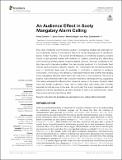An audience effect in sooty mangabey alarm calling
Abstract
How does intentional communication evolve? Comparative studies can shed light on the evolutionary history of this relevant feature of human language and its distribution before modern humans. The current animal literature on intentional signaling consists mostly of ape gestural studies with evidence of subjects persisting and elaborating with sometimes arbitrary signals toward a desired outcome. Although vocalizations can also have such imperative qualities, they are typically produced in a functionally fixed manner, as if evolved for a specific purpose. Yet, intentionality can sometimes transpire even in functionally fixed calls, for example, if production is adapted to audience composition. In this study, we carried out field experiments to test whether free-ranging sooty mangabeys adjusted snake alarm call production to their audiences. We found a positive relation between alarm call production and naïve individuals arriving, suggesting that callers attempted to influence their behaviors relative to the snake. Subjects called more with smaller audiences, if they had not heard other calls before, and if socially important individuals were in the area. We concluded that sooty mangabeys alarm call production can be explained as an active attempt to refer to an external event, rather than a mere readout of an internal state.
Citation
Quintero , F , Touitou , S , Magris , M & Zuberbühler , K 2022 , ' An audience effect in sooty mangabey alarm calling ' , Frontiers in Psychology , vol. 13 , 816744 . https://doi.org/10.3389/fpsyg.2022.816744
Publication
Frontiers in Psychology
Status
Peer reviewed
ISSN
1664-1078Type
Journal article
Description
Funding: This research has been funded by the Swiss National Science Foundation (310030_143359) and European Research Council (PRILANG GA283871).Collections
Items in the St Andrews Research Repository are protected by copyright, with all rights reserved, unless otherwise indicated.

